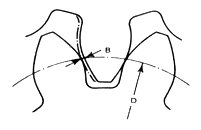Spur Gear Backlash Review
Gear Products and Suppliers | Gear Knowledge Menu
Spur gear backlash is the amount of tooth space between mating gears at the pitch circle diameter. Backlash may be measured or specified in the transverse, normal, or axial planes, and in the direction of the pit circles or on the line-of-action.
 |
The purpose of backlash is to allow smooth operation and reduce friction by preventing mating gears from grinding by contact on both sides of their gear teeth at the same time.
Minimal or no backlash may cause operation noise, overloading, and overheating of the gears, and even cause seizing and ultimately failure. Large amounts of backlash is not desirable, particularly if the gear train must reverse. Small amount of backlash (clearance) will require tighter tolerances for runout, pitch, profile, and the location of the operational bearing resulting in an increased cost of gears and assemblies.
Stock spur gears are cut to operate at standard center distances. The standard center distance being defined by:
Standard Center Distance = [Pinion PD + Gear PD] /2
When mounted at this center distance, stock spur gears will have the following average backlash:
| Diametral | Backlash | Diametral | Backlash |
|---|---|---|---|
| Pitch | (Inches) | Pitch | (Inches) |
| 3 | .013 | 8-9 | .005 |
| 4 | .010 | 10-13 | .004 |
| 5 | .008 | 14-32 | .003 |
| 6 | .007 | 33-64 | .0025 |
| 7 | .006 |
An increase or decrease in center distance will cause an increase or decrease in backlash. Since, in practice, some deviation from the theoretical standard center distance is inevitable and will alter the backlash, such deviation should be as small as possible. For most applications, it would be acceptable to limit the deviation to an increase over the nominal center distance of one half the average backlash. Varying the center distance may afford a practical means of varying the backlash to a limited extent.
The approximate relationship between center distance and backlash change of 14-1/2° and 20° pressure angle gears is shown below: For 14-1/2°–Change in Center Distance = 1.933 x Change in Backlash For 20° –Change in Center Distance = 1.374 x Change in Backlash From this, it is apparent that a given change in center distance, 14-1/2° gears will have a smaller change in backlash than 20° gears. This fact should be considered in cases where backlash is critical.